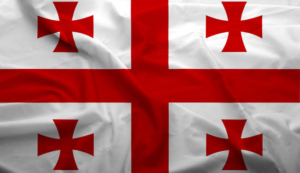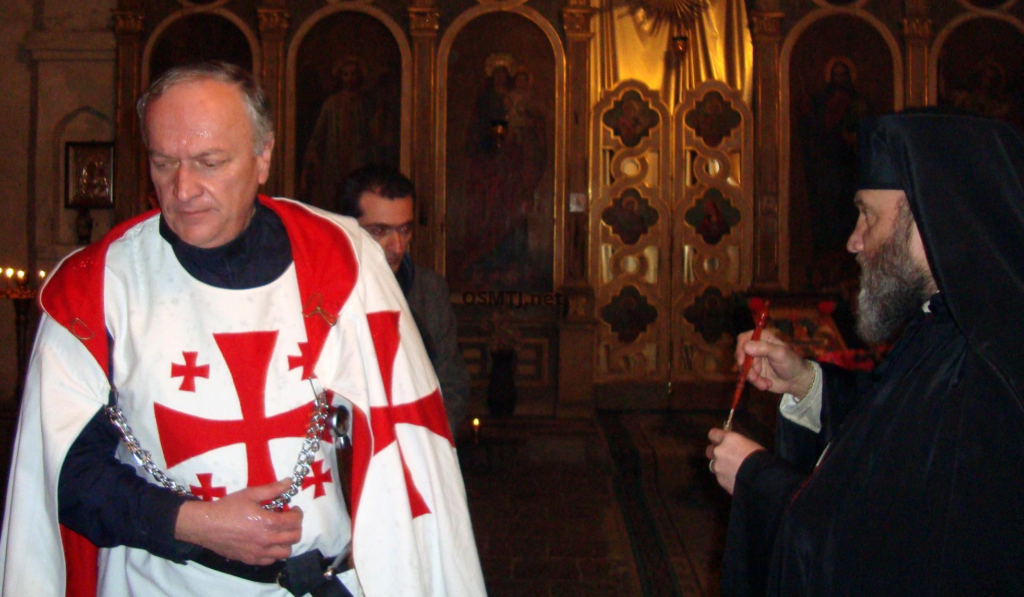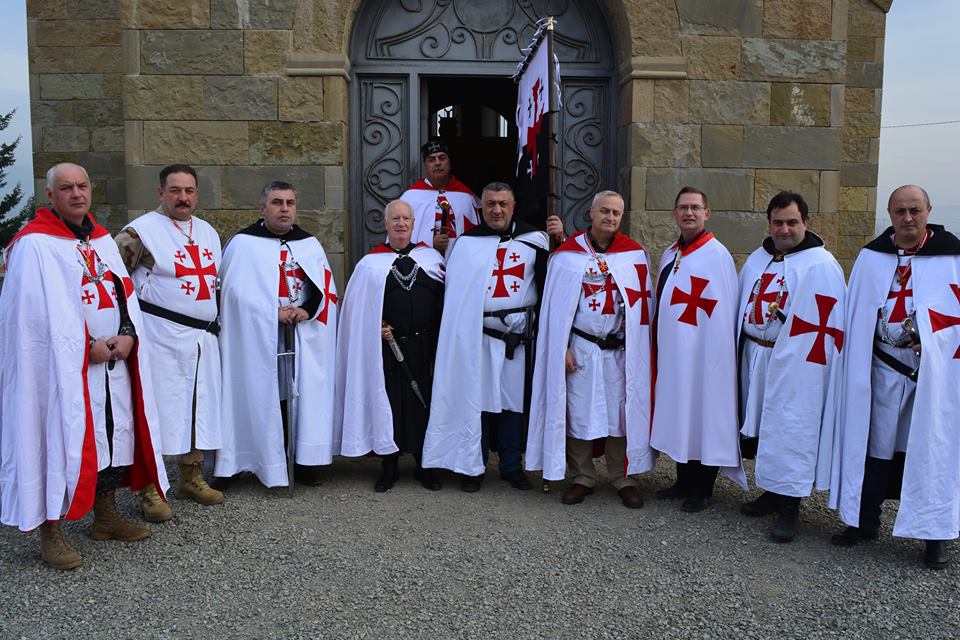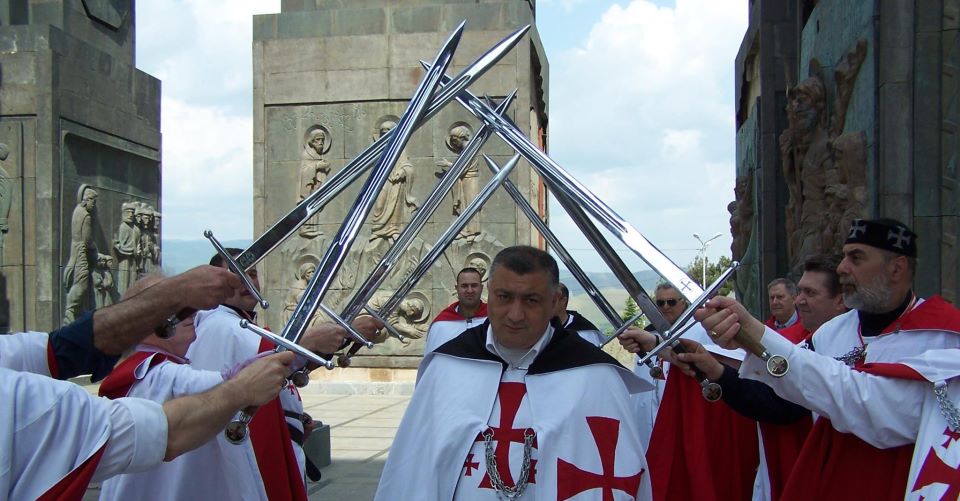Have you ever looked at the flag of the nation of Georgia and wondered why it had Templar crosses on it? Then read on. Note for the reader: Georgia is one of the oldest Christian nations in the world having been converted in the 4th century after Christ’s death. The word for “Templar” in Georgian is “Tadzrelebi” which literally means “people of the temple“. The Original Tadzrelebi, according to some Georgian historians, predates the founding of the Knights Templar of the Crusades. The Tadzrelebi probably began to organize in the 5th century because Georgian monks founded monasteries in Palestine and Jerusalem as early as the 5th century.
The Georgian Tadzrelebi (“Templars”)
By Merab Surguladze, 2010
The Tadzrelebi have been inappropriately linked to the Crusading Knights Templar who fought with King David IV Arghdamenishabeli at the Battle of Didgori to defeat the Seljuk Turks and capture Tbilisi. But the Tadzrelebi tradition is much older than the Christian Crusades. What follows is a description of the history of the original Tadzrelebi and its connections to Europe. These connections support the intent of Georgia to rejoin the Euro-Atlantic community through NATO and the European Union. There have been some misunderstanding of the purpose of the Tadzrelebi and this article will answer some the questions as to why the Tadzrelebi are truly a Georgian tradition that supports the nation of Georgia and supports the traditions of the Georgian Orthodox Church. The Original Tadzrelebi. According to some Georgian historians (literal Georgian: ‘people of the temple’), predates the founding of the Knights Templars of the Crusades. The Tadzrelebi probably began to organize between the 5th but may have even older roots. As Georgian monks founded monasteries in Palestine and Jerusalem as early as the early 5th century.
“Nobles of the Church” and “Nobles of the King” – Tadzrelebi
The oldest Georgian monastery discovered so far may be the one of St. Tevdore [Theodore] in the Jordan desert near Bethlehem in Palestine. Abbot Anthony left Georgia in 532 and worked in Palestine until 552 before becoming a bishop elsewhere. He renovated or improved an even older Georgian monastery whose royal and saintly founder is mentioned in an inscription: ‘Saint Theodore, Maruan and Burzen … en’ and ‘… and born by breasts, Bakur and Griormizd, Christ forgive them. Amen.’ Maruan was born in 409; son of Georgian King Bakur’s daughter, Bakurduxt, and Burzen (or Buzmir), king of Iberia and Kartli. Persia and Byzantium were then fighting over Georgia, which leaned toward the Byzantines and Emperor Theodosios II (408-450) demanded King Burzen’s 12 year old son Maruan as hostage. From 422 onward Maruan was raised in Constantinople by the emporer’s wife, Evdocia. At 20 years of age, Maruan ran away to Palestine, to become a monk called Peter, co-named the Iberian. From 429-444, Maruan-Peter, built several churches in Palestine, including one and 8th centuries, Century, the monasteries were protected by the Tadzrelebi. In Jerusalem Maruan-Peter also built a monastery in the Jordan desert, and it is here that the ruins with Georgian writing were found which date between 429 and 444. From other sources we know that the king provided guards for the churches and monasteries. Ancient texts tell that these Georgian Templars were fierce fighters feared by their enemies. Consequently, one may say, the temple-related tradition in Georgia is much older than the Knights Templar. This conclusion is the subject of much Georgian pride and may be recognized for its inherent value.
Tadzrelebi Connections to the Georgian Orthodox Church
The Tadzrelebi fully support the traditions of the Patriarchy and the Georgian Orthodox Church. The Tadzrelebi and its members individually were blessed as warrior-protectors of the Georgian Orthodox Church by Archimandrite Eqvitime in a centuries-old ceremony at Annanuri that had not been conducted in over 200 years (before the Russian occupation of 1781).
Although Christianity was introduced to the highlands of Georgia by St. Nino during the early 4th Christianity in west Georgia, anciently known as Colchis or Lazica, is commonly believed to date to the time of the Apostles. There exist several traditions in Georgia. One maintains that Mary, the Mother of Christ, dispatched the Apostle Andrew, the century, the history of First Called, to preach the gospel in Georgia. Andrew came to Georgia to find the Mantle of the Prophet Elijah, brought to Mtskheta by Jews persecuted by Nebuchodonosor in the 6th century B.C. Also, a seamless Chiton of Christ had been obtained after the crucifixion of Christ and brought to Mtskheta . The Apostles Matthias and St. Simon of Canaan preached in Georgia and both are buried on the Georgia Black Sea coast. In addition, the Apostles Bartholomew and Thaddeus visited East Georgia and preached there. It is from Andrew’s founding of the Christian Church in west Georgia that the Georgian Patriarch claims autocephalous descent directly from the Apostles of Christ. Finally, the robe of Mary the Mother of Christ has been kept for centuries in a monastery in West Georgia (now the museum of the Dadiani Palace in Zugdidi, Georgia) Tadzrelebli connections to the Royal House of Georgia – Bagration-Mukhrani or Mukhraneli. The Tadzrelebi honor the traditions of the Royal House of Georgia. The Royal House of Georgia claims to be one of the oldest Royal Houses in the world.
History of Georgia’s connections to German speaking Europe
Georgia has long historical contacts with German speaking Europe dating from at least the 4th Century A.D. Zebulon, the father of Saint Nino of Cappadocia who brought Christianity to Georgia in around 330 A.D. (Armenia and Georgia fight over the honor of being the oldest monarchical state to adopt Christianity), is revered as a German Saint along the Rhine River for converting pagans. There was contact between Frankish and Georgian knights at least during the Crusades. For example, recent evidence strongly indicates that King Baldwin II of Jerusalem was present with 100-200 Frankish knights in Georgia in August 1121 to assist Georgian King Davit Aghdamenishebili (the Builder) defeat the Seljuk Turks at the Battle of Didgori. In 1189, during the 3rd in Georgia Petritsioni to discuss relations between Germans and Georgians with the Byzantine Empire. Holy Roman Emperor Frederick Barbarossa wanted his son to marry Queen Tamara of Georgia. During the reign of Queen Tamar’s son-King Giorgi IV Lasha, Pope Honorius III called on Georgia to participate in the 5th Crusade with the King of Hungary Ardrosh II, Duke Leopold IV of Austria (Babenberg) and Duke Otto of Meran. Before the king of Georgia Giorgi Lasha prepared for this crusade – he received a relic of the Holy Cross from the Pope. In 1219, the Crusaders took the city of Damietta (in Egypt) and it is stated in the ecclesiastical annals of the Vatican: “in 1219. Georgians infused the spirit of victory in the army of the crusaders.” Monk-chronicler Volaterano wrote: “when the Sultan of Damascus surrounded Damietta, the city came to the Georgians to take part in a holy war, which involved a large part of Christianity.” Elsewhere in the same Chronicle it is said: “Saracens were afraid. All have seen the power of Christians. Georgian Crusaders fortified the fighting spirit that at last freed Damascus itself.” Fast forwarding to the 19th for religious reasons. As members of the Pietist sect, they desired to go to the Holy Land and await the Second Coming of Christ. Since political factors did not allow that, they appealed to the Russian Czar, then the new overlord over Georgia, for permission to settle as close to Palestine as possible and to wait for an opportunity to migrate further at a later time. As the Czar’s mother and Grand-Duke Mikhail Pavlovich’s wife had been former princesses from Wuerttemberg, the wish was granted. Within a few years several colonies were established: Marienfeld, Elisabeththal, New Tiflis (now part of Tbilisi), Alexandersdorf, Petersdorf, Katharinenfeld, Helenenfeld and more, all of Crusade, Frederick I Barbarossa met the abbot of a monastery Century, some 20,000 Germans migrated to settle in Georgia. Three later colonies were founded in what is now Abkhazia: Neudorf, Gnadenberg and Lindau.
By 1918 Germans lived in over 20 towns. Numerous commercial and personal links were established between Germany and Georgia, many of them through aristocratic links via St Petersburg. Among them, to name a few outstanding examples, a Duke of Oldenburg, who married Georgian princess Dadiani, and a Duke of Sachsen-Altenburg, who from 1868-9 and 1874-5 twice held the most important military command in Georgia, or a daughter of one of the Sachsen-Altenburg=Romanov marriages, Tatyana, who married Prince Konstantin A. Bagrationi-Mukhraneli (who is buried in front of the main altar at Sveti Skhroveli). From 1906 to 1922 Kurt von Kutschenbach published the German-language newspaper Kaukasische Post that called itself the “only German newspaper in the Caucasus”. Editor-in-chief was the writer and journalist Arthur Leist. The newspaper was revived during the late 1990’s. When Georgia declared independence from Russia in 1918, Germany was the first of the first European nations to recognize Georgia. By the German-Georgian Treaty of Poti, in May 1918, Imperial Germany granted recognition and protection of Georgia. General Kress von Kressenstein directed the German Caucasus Expedition to give military support to the Democratic Republic of Georgia against the Bolsheviks in Abkhazia in 1918. Austria-Hungary and other countries followed very soon.
Georgia raised two regiments of soldiers (“legions”) to fight with Germany in WWI and to fight communism in WWII. The World War I Georgian Legion was formed in 1915 by Count Friedrich Werner von der Schulenburg, a former German vice-consul in Tiflis, who then served as a German liaison officer with the Ottoman 3rd Army. He was supported by the German imperial Committee of Independent Georgia. With approximately 1,500 Georgian soldiers, the Legion was commanded by German Lieutenant Horst Schliephack. During the years of Georgian independence, from 1918 until February 1921, many Germans and Austrians came to the support of Georgia, either with military advice or with commercial investments. Among them, for example, Duke Ernst II von Sachsen-Altenburg, who -with the money received for his expropriated properties – bought several properties and mines. During the Second World War, the Wehrmacht’s ethnic Georgian Legion was formed from émigrés living in Western Europe after the 1921 Soviet invasion of Georgia, combined with Soviet prisoners of war of Georgian origin who were enlisted in German POW camps. At least 30,000 Georgians served in the German armed forces to fight the Soviets.
By the time of Stalin’s deportation of Germans there were more than 24,000 Germans living in Georgia. From October 1941 to April 1942, a total of 19,186 German people, were deported to Kazakhstan, Siberia and elsewhere by the Soviets. In 2009, Germany was Georgia’s fourth-largest trading partner, after Turkey, Azerbaijan and Ukraine. Germany is Georgia’s second-largest bilateral development cooperation partner after the United States. Since 1992, it has pledged some EUR 400 million in development assistance. Germany is coordinator of the UN secretary-general’s Group of Friends of Georgia, and pays special attention to the problems between Georgia and the separatist territories of Abkhazia and South Ossetia. In 2006, a resolution of the U.N. Security Council granted special opportunities to Germany to help ease the tension between Georgia and the separatist regions, which, regrettably, did not halt the slide into a war in 2008. Today, there exist many Templar connections between Georgia and Germany and Austria. Gabriela von Habsburg is Georgia’s current ambassador to Germany at Berlin.
–
For further reading in Georgian: http://ejournal29.com/journals_n/1452799470.pdf
*Copyright Merab Surguladze 2010, All rights reserved, used with the express permission of Merab Surguladze.




